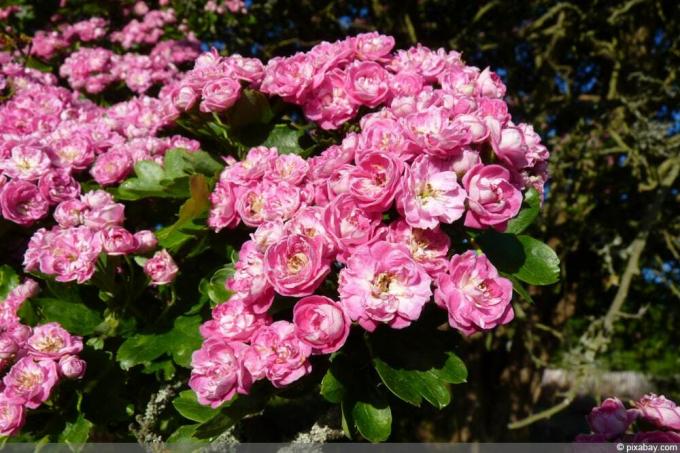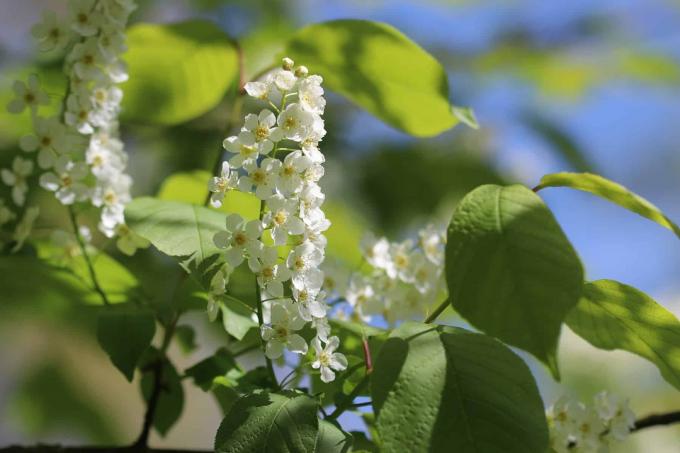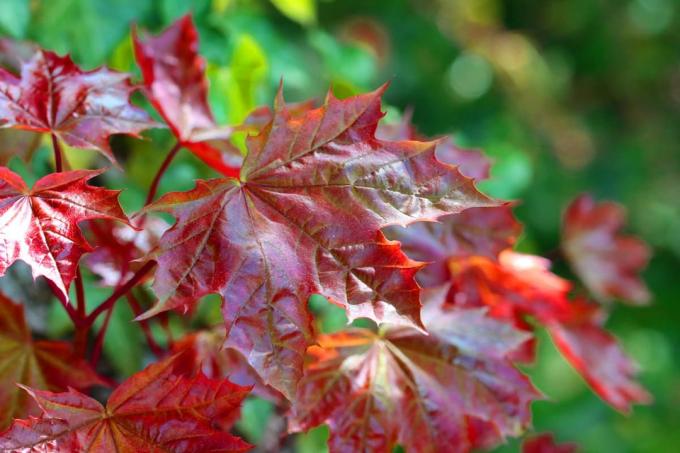

Table of contents
- Location
- substrate
- Plant
- Pour
- Fertilize
- waste
- Radical blend
- Culture in the bucket
- repot
- propagation
- Propagation via seeds
- Propagation via root suckers
- Propagation via grafting
- hibernate
- Typical diseases, pests and care mistakes
- Caution: thorns
Although the hawthorn tree is not demanding and a wonderful beginner's plant, as it does not require much care, there are still a few points to consider when cultivating it. Above all, the choice of location is important, because the hawthorn tree can take on surprising proportions. However, other factors are also important. But what is important and what needs to be considered?
Location
Whether next to a road or in the garden - the main thing is sunny. The hawthorn tree does not need protection from wind and weather, but should be in full sun or at most in semi-shade. If the location is too dark, this is noticeable in weak growth and usually also in a decrease in flowering power. Otherwise, the hawthorn tree is resilient and even tolerates urban climates without any problems.
Another important factor when choosing the location is the space required by the hawthorn tree. It can reach heights of between four and ten meters and thus has a corresponding circumference. A permanent small by regular cuttings is possible, but increases the maintenance effort. Because if the hawthorn is kept small, compensatory care is required. It is therefore easier and more sensible in the long term to choose a suitable location directly. Above all, this should offer space upwards and also have a distance of at least three to four meters to buildings and other tall plants.
The proximity to paths and driveways, on the other hand, is not a problem. Since the hawthorn tree is a deep-rooted tree, damage from spreading roots does not have to be expected.
substrate
A high nutrient content in the substrate is particularly important for hawthorn. Compost, pre-fertilized soil or rose fertilizer are recommended for this. In addition, the soil for the hawthorn tree should be permeable but not too light. Well suited are, among others:
- Garden soil that is enriched with clay or loam
- bucket soil
- Loamy topsoil
- rose soil
Mixtures of these components can also be used. Anyone who has just built can usually use the excavated material directly - as this often has a high clay content and would normally be disposed of.
Plant
The hawthorn can be planted as a tree or shrub all year round. However, the ideal times are in spring and autumn. When planting, the following steps are important:
- The planting hole should be three times as deep and wide as the root ball.
- Fill the planting hole with the substrate mixture described above so that the hawthorn can still be planted with the surrounding soil line.
- After inserting the hawthorn, the planting hole is filled all around with soil and the substrate is pressed down.
- Floating watering ensures that the roots can spread more quickly in depth.
Tip:
If the substrate has not been mixed with compost or pre-fertilized soil has been used, a fertilizer should also be used when planting. However, it should be used sparingly in autumn and winter.
Pour
The only thing that is really necessary is watering the hawthorn:
- in bucket culture
- during prolonged dry periods
- when fertilizing for a better distribution of nutrients and to prevent chemical burns on the roots
- after planting until growth

However, the hawthorn tree thrives particularly quickly and well if the substrate is always kept slightly moist. However, it does not tolerate waterlogging.
It is also recommended to use soft water for watering. Low in lime and therefore soft are, among other things:
- stagnant tap water whose sediment is not used
- filtered water
- untreated pond water
- rainwater
Fertilize
As mentioned, additional nutrients should be added to the substrate when the hawthorn is planted. But the following are also suitable:
- rose fertilizer
- compost
- leaves
- Long-term fertilizer for shrubs
Depending on the fertilizer chosen, fertilize once or twice a year. A sparing dose in spring and summer is ideal. It is important to water the plant extensively. In this way, the nutrients are distributed more evenly in the soil and excessive concentrations are avoided. This avoids harmful reactions between highly concentrated fertilizers and the roots – so-called chemical burns.
waste
Annual pruning is recommended so that the hawthorn grows densely and vigorously and also reduces the risk of pest infestation. This should be done in summer immediately after flowering, otherwise the buds will be removed for the next flowering. The following are blended:
- crossing and inward growing shoots
- damaged plant parts
- Water shoots that are weak and thin
- Branches too close together
It should be noted that the buds or flowers only appear on two-year-old shoots of the hawthorn tree. Older branches and main shoots should therefore not be cut. It is also important to use clean cutting tools so as not to risk infection. In addition to this yearly grooming cut, more radical trimming may also be required.
Radical blend
Whether the tree or shrub grows too large or has been attacked by pests - in some cases it is necessary to prune the hawthorn more radically. Such an occasional radical pruning can be tolerated by an otherwise healthy and strong hawthorn tree although the trimming is done annually to limit the size, the grows maintenance effort.
In the event of a disease or pest infestation, all affected parts of the plant should be removed and an appropriate pesticide used. The disinfection of the cutting tools before and after use is crucial in order not to transmit the germs or parasites.
Culture in the bucket
As long as the hawthorn is still small, it can also be cultivated in a bucket. The following factors are important for this type of culture:
- Sufficiently large and high bucket so that the deep-rooting plant can spread accordingly
- frequent watering
- annual fertilizing
- Repot as needed
The maintenance effort here is therefore a little higher than with hawthorn outdoors.
repot
When cultured in buckets, repotting is also necessary as a maintenance measure. This is done when the plant's growth slows down or roots can be seen at the bottom of the pot.
The procedure is as follows:
- Remove the old substrate from the root ball and carefully rinse away any remaining soil.
- Prepare fresh substrate and, if this is not already pre-fertilized, mix in well-rotted compost or rose fertilizer.
- Choose a planter that is one to two sizes larger than the previous bucket.
- After inserting the vessel, immerse it or pour it over it.
propagation
The hawthorn can be propagated in three ways:
- about seeds
- through root suckers
- by grafting on hawthorn
Propagation via seeds

After the flowering period, the hawthorn produces fruits containing the seeds. If the fruits are dried and opened, the seeds can be spread on potting soil. However, germination takes a long time, so patience is required.
Anyone who decides to do so should note the following points:
- Always keep the substrate moist
- Place the culture vessel in a bright, warm place
- If possible, cover the container with foil or a pane of glass and air it daily
If germination occurs after several weeks or months, the young plants should be from a height of about ten centimeters and placed in the nutrient-rich substrate described above become. In the early days, it also makes sense to continue cultivating the plants indoors in a bright, warm location. Only from a height of 20 to 30 centimeters should they be placed outdoors in warm weather.
Propagation via root suckers
The easiest and quickest way to propagate hawthorn is to use root suckers. If there are young plants about 15 to 20 centimeters high, they are generously dug up and planted separately.
With this variant of propagation, there are no waiting times and no skill or extensive knowledge is required.
Propagation via grafting
The hawthorn can also be propagated by grafting a cutting onto a hawthorn trunk - i.e. grafting it. However, this requires the appropriate knowledge and tact. Even then, there is no guarantee of successful propagation of the hawthorn tree.
The variant is therefore not suitable for beginners in plant care.
hibernate
Hawthorn trees planted outdoors are extremely frost hardy and therefore only occasionally require additional winter protection. This applies, for example, to planting in autumn. Since the hawthorn does not have enough time to grow completely before the frost sets in, the roots should be protected. This also applies to very young plants. It is advisable to pile insulating materials on the tree disc. Suitable for this are among others:
- leaves
- straw
- compost
- brushwood
If compost is used, fertilizing in the spring can be omitted. As the temperature increases, nutrients are increasingly released from it.
If the hawthorn is cultivated in a bucket, it should be hibernated indoors. Here it should be bright, cool but frost-free at temperatures of up to 18 °C. If the plant is overwintered indoors, it should also be watered from time to time. A complete drying out of the substrate should urgently be prevented.
Typical diseases, pests and care mistakes
In itself, the hawthorn is a hardy and robust plant. Unfortunately, it is still not safe from diseases and pests. Infestation or infection with:
- aphids
- Web moths and their caterpillars
- fire blight
Aphids like to feed on the sap of the hawthorn leaves, but they are also easy to combat. Natural predators such as ladybugs can be used against them. Pesticides that are gentle on beneficial insects and contain potash soap or rapeseed oil are also suitable. In the case of a very light infestation or as a pre-treatment, the leaves can also be sprayed with a jet of water.

Combating the spider moths and their larvae is somewhat more difficult. The pests spin webs reminiscent of cobwebs. The larvae or caterpillars are visible in these. Spraying with an appropriate pesticide is difficult because the moths' nets prevent adequate wetting. Therefore, they must first be removed. Possibilities for this are the winding of the nets on a stick, the targeted burning or a radical cutting of the infested parts of the plant. Only then should pesticides be used.
Fire blight is particularly dangerous and must be reported. This is a bacterial infection. He can be recognized by:
- conspicuously dark leaf veins
- Leaves and shoots turn dark to black, but do not fall off
- growth is noticeably reduced
If the infestation is still limited to small sections, affected parts of the plant are radically cut off and destroyed. In combination with this, an appropriate pesticide must be used. In the case of an advanced infection with fire blight, the entire hawthorn must be destroyed in order to prevent the bacteria from spreading.
Typical grooming mistakes include:
- wrong or too dark location
- lack of fertilization
- frequent watering with lime-rich water
- complete drying out or waterlogging
- an annual over-abatement to limit size
Therefore, if growth or flowering is poor, the culture conditions should be checked.
Caution: thorns
As the name suggests, the hawthorn has thorns. These are very long and pointed, which makes cutting difficult and also dangerous for pets and children. If they get too close to the plant while playing, they can easily injure themselves on the thorns. This also applies to the area immediately below and around the bush or tree, because the thorns can also fall off. Anyone who likes to walk barefoot in the garden should therefore avoid the hawthorn.
When cutting, puncture-proof work gloves should also be worn to avoid injuries to the hands. Safety goggles are also useful to prevent falling or flying thorns from getting into your eyes.
 garden editorial
garden editorial I write about everything that interests me in my garden.
Learn more about Baumlexikon

Bird cherry, Prunus padus: caring for, pruning & propagating
The bird cherry is a shrub or tree that is the ideal bee pasture in a natural garden. However, the plant should also be viewed with caution, as it is a poisonous plant for horses. Nevertheless, it is popular in the local colorful hedges.

Red maple: 9 tips for caring for, cutting & overwintering
The red maple is one of the most impressive trees in Germany due to its unusual scarlet leaf colour. Here you can find out how to integrate this impressive plant into your garden and how to keep it healthy and vigorous.

Sycamore tree: Properly care for and cut sycamore trees
The plane tree (Platanus) has a high decorative value. In terms of care, it is mostly undemanding, which is why it is often chosen as a street tree. Nevertheless, there are a few details to be observed when it comes to care, as described in the home garden guide.

Birch locations: 5 important criteria
Birch trees are extremely frugal trees and are particularly eye-catching and decorative thanks to their light-colored bark. When choosing a location, however, a few factors should be considered in order to create optimal conditions for their growth and to protect the environment.

Cutting dwarf pine - instructions for the perfect cut
Dwarf pines can be pruned by thinning out, topiary or limbing. A bonsai design with needle and root pruning is also possible. So that the wood does not look unattractive after the pruning measure, a few rules of technology should be observed.

Is the vinegar tree poisonous? | Who is it dangerous for?
In ornamental gardens, the vinegar tree is an attractive eye-catcher due to its unusual flowers and the appealing autumn color of its feathered leaves. The red, upright fruit cobs (flowers) are responsible for the striking appearance. Despite everything, the vinegar tree is not an unproblematic tree.
